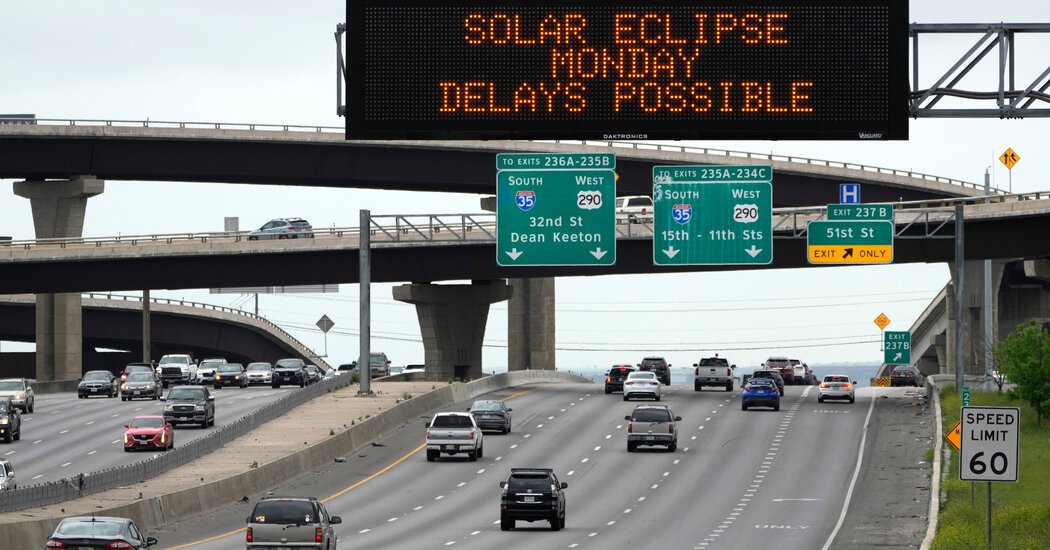Millions of people will tilt their heads skyward on Monday, marveling at a total solar eclipse. The moon will cross the sun and block its light for a few fleeting moments, a communal celestial experience that will not again be so accessible to people in the United States, Canada or Mexico for decades.
The total solar eclipse’s path — the expanse where the moon fully obscures the sun — stretches from Mexico’s Pacific Coast to the fringes of Atlantic Canada, passing through dozens of major cities where authorities are preparing for an influx of visitors eager to experience what may be a once-in-a-lifetime opportunity.
In New York, signs along the Thruway urged travelers to “Arrive Early, Stay Late” to avoid the inevitable jams that will clog routes to and from the eclipse’s path.
Closer to Niagara Falls, which is in the path of totality, the second half of the message switched to a more realistic, “Expect Delays.”

It will be the first total solar eclipse visible from the United States since 2017, and there will not be another that is visible in the lower 48 states until 2044. On Monday, much of the country is expected to take in the view. In 2017, a majority of American adults — 154 million, according to an estimate by Jon D. Miller, a University of Michigan research scientist — watched the eclipse in person, an audience far beyond that of even the most-watched Super Bowl (123.4 million this year). And the path of totality for Monday’s eclipse crosses over more than twice the number of people as the 2017 event.
Many eclipse-gazers are anxiously checking forecasts, hoping the clouds will part on Monday afternoon. The National Weather Service’s eclipse forecast shows potential cloud cover across much of the event’s path, including San Antonio, Buffalo and other major cities. In some places, rain may fall during totality.
Cities have canceled school across the country, and millions of protective glasses are being distributed or sold. Scientists have warned people never to look directly at the sun without protective eyewear because serious retinal injuries can occur.
Across North America, a wealth of special events are being planned, from street parties in Mexico to a study of animals at a zoo in Indianapolis to a special eclipse display at Niagara Falls.
In Mazatlán, the coastal Mexican city that will be one of the first places where people can see the eclipse from land, hotels are at capacity, cruise ships are offering special eclipse experiences and the seaside promenade is teeming with tourists.
Authorities said they were expecting about 120,000 people to visit Mazatlán for the event. The few hotel rooms available were going for triple or quadruple normal rates.
“This is where the eclipse hits land,” said Greg Schmidt, the director of NASA’s Solar System Exploration Research Virtual Institute, who arrived in Mazatlán several days ago with a team that will livestream the eclipse from the city.
Mr. Schmidt selected Mazatlán about two years ago as his team’s site to follow the eclipse. He sounded sanguine about the choice compared with other places along the eclipse’s path; weather forecasts were favorable for high cirrus clouds.
“We should at least be able to see totality through that,” he said, contrasting Mazatlán with Texas, which “is now showing a lot of problems weather-wise.”
In Dallas, more than a thousand miles away, many people were already resigning themselves to not being able to see the eclipse, and some talked about venturing to see the next one in Iceland or Spain in 2026.
Eric Isaacs, the president of the Carnegie Institution for Science in Washington, D.C., which was hosting a three-day feast of science and sightseeing in Dallas for donors and friends of the institution, said the group’s viewing location had already been shifted to a mansion where people would be able to gather inside if they needed to get out of the rain.
Closer to the end of the eclipse’s path, Canada’s Niagara region declared a state of emergency 10 days before the event, allowing officials to expedite safety and police resources if needed.
The emergency declaration added to the mild sense of panic that has settled over Niagara Falls and several large cities within a two-hour drive of the city, including Hamilton and Toronto.
Back over the U.S.-Canada boundary in New York State, Jessica DeCerce, the governor’s director of interagency operations, said officials were preparing for the eclipse as they would for a weather catastrophe. The total eclipse will be visible across a wide swath of the state. New York City is outside of the path of totality, but it will experience about a 90 percent eclipse around 3:25 p.m. Eastern.
Ms. DeCerce has been nicknamed the state’s “eclipse czar” and has been spending the last two years thinking of everything that could go wrong: traffic gridlock, a lack of bathrooms, shaky cellphone service.
She did not want to name one spot she thought would be best to view the eclipse, but she said it would be difficult to beat Niagara Falls.
“Can you imagine a better place to watch this than in front of one of the world’s natural wonders?” she said.
Some experts have said that the rainbow that usually forms in the mist of the falls will turn pink during the eclipse.
Elliott Cohen, 33, who drove to Niagara Falls with members of his rock band from Hartford, Conn. — because “there’s nothing more spiritual than experiencing an eclipse” — said he and his group were weighing whether to view the event from a friend’s backyard or the state park.
“We like to do things on a whim,” he said.
In Indianapolis, which is in the path of totality, officials at the city’s zoo plan to distribute as many as 10,000 pairs of eclipse glasses to visitors and have ensured that the zoo’s automatic lights will not turn on when the sky darkens.
“We absolutely cannot have the lights go on and ruin the atmosphere,” said Emily Garrett, a zoo spokeswoman.
Alicia Bonanno, an operations coordinator in charge of several parts of the zoo, including the macaw area, said she couldn’t wait to find out how the macaws would react to the eclipse.
“The disturbance in air pressure might cause them to fly around because they feel like it’s going to storm,” she said, as the birds squawked in the enclosure in front of her. “But what they actually do during totality might be different. They could just tuck in for the night. We’ll just have to see.”
Reporting was contributed by Vjosa Isai from Toronto, Juliet Macur from Indianapolis, Dennis Overbye from Dallas, Simon Romero from Mazatlán, Mexico, and Jay Root from Niagara, N.Y.










